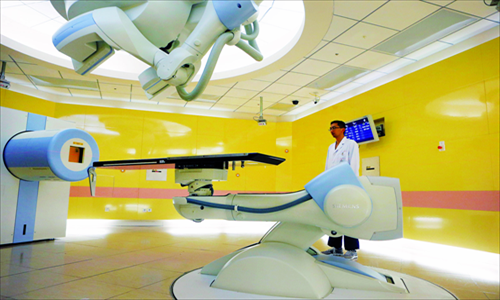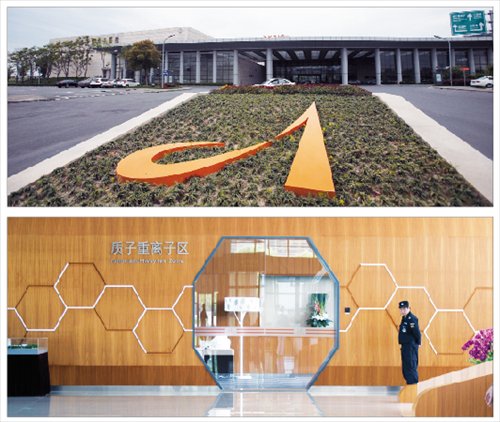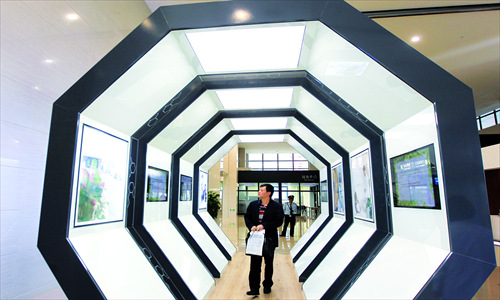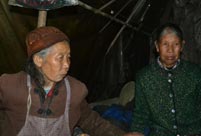

Giving cancer a kicking
It offers some hope for many but the Shanghai Proton and Heavy Ion Center is not rushing its radical cancer treatment programs despite a great deal of pressure. The center officially opened this month and it has already seen nearly 1,500 patients at its outpatient department and handled more than 3,400 phone inquiries.
Last Friday alone, some 100 sick people from all over the country arrived at the center in the suburban Pudong New Area. Although they'd come with high hopes and were more than willing to pay for a procedure that costs on average 278,000 yuan ($44,834), the sad reality was that the vast majority of them were not suitable cases for proton or heavy ion treatments.
A form of particle therapy, this new technology is a major advance on traditional radiotherapy treatments. Due to the physical characteristics of proton and heavy ion, especially equipped with pencil beam technology, the radiation can very precisely target the diseased areas in a body and reduce the negative effects on surrounding healthy tissue.
However, this treatment is only suitable for some very specific patients with specific forms of disease. In the past two weeks the center has accepted just 12 patients - the youngest aged 23 and the eldest 68.
"Proton and heavy ion treatments are not magic, but an invisible edge knife. The successful application of the knife depends on how we can take full advantage of the technology with more advanced understanding. In fact, we have to carefully select appropriate candidates for the treatment to make sure that these advanced technologies are being properly used," said Fu Shen, the director of the radiation oncology department at the center.

A doctor looks over proton and heavy ion equipment.
Clinical trials
How this new technology can actually help patients with cancer is shown in the case of the Jiangxi woman, Liu, who was diagnosed with a tumor in her spinal cord. She was one of the 35 patients to be treated at the center when it underwent clinical trials between June and September last year. When a tumor started to compress her optic nerves and brain stem, Liu suffered severe headaches and began losing her sight.
In 2013, she had to opt for the traditional treatments which included brain surgery and radiotherapy afterwards. But because of the location of her tumor, surgeons could not remove it completely. Six months after her operation the tumor began to grow again and within a short period of time she couldn't even get her right eye opened.
In July last year, Liu was accepted for treatment in the trial period at the proton and heavy ion center. The executive vice president of the center, Lu Jiade, explained that Liu's tumor was right beside her optic nerve chiasm, where the optic nerves partially cross in the brain, and the slightest miscalculation in surgery would have resulted in the woman being permanently blinded.
"It's an area of just 3 to 5 millimeters. Traditional treatments could not help here. We had to get a very high dose of particle radiation to the tumor while ensuring there was little or no damage to the surrounding nerves," Lu said.
The treatment was completely successful. The tumor shrank and is still receding. And there were few of the crippling side effects which traditional radiotherapy can produce.
"I didn't feel anything during the procedure. I once saw a girl with a brain tumor whose face and neck had been burnt after she had radiotherapy," Liu said.
Other patients in the trial period also saw their tumors shrink. All of the 35 patients were given a total of 843 doses of proton and heavy ion radiation. None reported weight loss or side effects severe enough for them to suspend or stop the procedures. By April this year, none of these patients complained of any side effects.

The proton and heavy ion center in Pudong New Area
Not exactly new
The techniques are not exactly new. In the mid-1970s, protons started to be used to treat tumors and director Fu Shen said that to date the technology has been used to treat tumors in more than 100,000 patients around the world.
Heavy ion therapy has only been in vogue since the 1980s and from the 1990s up to 2013 it had been used to treat about 10,000 patients. "Heavy ion treatment is very expensive and few patients are suitable for this form of treatment," Fu said.
He said that of the 30-plus facilities around the world that provide these treatments, only six or seven of them can offer heavy ion therapy.
Fu said that for him, the difference between photon, proton and heavy ion treatments was like the difference between weaponry. "If the photon is like a machine gun, then the proton is a hydrogen bomb and the heavy ion is an atomic bomb."
While they release different forms of energy proton and heavy ion radiotherapy treatments target very precise areas. Fu said given that heavy ion treatments have to date only been used on about 10,000 patients worldwide, it was not yet accepted as a standard procedure.
But within a group of prostate cancer patients, he said heavy ion treatments have proved to be remarkably effective. "Figures from Japan indicate that for patients with extremely high risks of the recurrence of prostatic cancer, the use of heavy ion therapy can effectively increase their five-year survival rate by between 15 and 20 percent compared to conventional radiotherapy. That's an exciting figure."

A visitor looks over a section of the newly opened center. Photos: Yang Hui/GT
Creating problems
Given the successful trials and the promise of fewer side effects, many cancer patients have seen the new facility as their big hope. And this is creating problems. Even though the center insists that patients have to make appointments to see one of the center doctors, many are just turning up, hoping to be treated.
Shortly after the center opened, more than 200 patients from around the country have arrived at the center without appointments on May 11. Staff have found some waiting in the dark before sunrise.
But even though the center tries to accommodate these desperate souls, most of the patients they see do not match the criteria needed for these special treatments.
To save the patients money (it costs 498 yuan to register), the center tells everyone involved to call first and check whether their conditions are suitable for these treatments.
Recently the center published a list of seven categories of tumor patients that cannot receive proton or heavy ion treatments and these include patients who have multiple distant metastases or in the terminal stage of the disease, those suffering hematological malignancies, patients who have undergone radiotherapy more than twice in the same tumor area, patients with seed plant history in the same tumor area, patients with tumors in cavity like the esophageal, stomach or colorectal carcinoma, and patients who cannot lie still on their stomachs or backs for comparatively long periods.
Children under the age of 14 are not suitable for these treatments either.
Director Fu said that the center's outpatient doctors made a preliminary decision on whether a patient was potentially suitable for proton or heavy ion treatment, then a panel of experts discussed each case. "We would have multidisciplinary treatment discussion for every single case and to make sure that our treatments are safe and effective for the patients."
He said there were some cancers that responded to these treatments better than others like tumors in the brain, neck or nasal cavities and some melanomas. "Proton treatment can work quite well in such cases. It can also be used to treat thoracic neoplasm like non-small cell lung cancer, liver cancer and pancreatic cancer."
He emphasized that it was vital that there was good communication between doctors and patients so that the most appropriate treatment plans can be selected. "That's why we insist on appointments and it is the rule that our doctors must spend at least 15 minutes on each consultation."
A major cost
It has taken more than 10 years for the center to come into being and it is the first in China and only the third in the world. Construction began in 2009 and it was completed in 2012. It was not a cheap project either. The average cost internationally for each proton treatment equipment is $95 million and the annual maintenance bill comes to $25 million.
Which is one reason why treatments at the Shanghai center cost an average 278,000 yuan. Patients have to pay this themselves - there is no reimbursement from the national health insurance scheme. But the cost in Shanghai is below the international average.
Usually patients at the center are hospitalized for between eight days and six weeks.
"The time is determined by the nature of the tumor and its location. If we can give a larger dosage of particle radiation to a tumor every day, the treatment time will be shortened," Fu said.
With 220 beds, for its first year of operation the center aims to receive a mere 300 patients. Fu Shen explained that it was early days for these treatments and it was complicated to come up with specific treatment plans for individual patients.
"We have to carefully select whether we use proton or heavy ion or a combination of both. We also need to choose the radiation range, the daily dose and the angle of the radiation beam to ensure the treatment is effective. After the 35 cases in the past year, we have got some experience. But we have to be aware that we still need more time to further advance our knowledge in terms of the diseases and the innovative technology for the sake of the patients. We must never compromise quality for the sake of quantity."
The president of the center, Guo Xiaomao, has told media that what makes the proton and heavy ion equipment special was its precision which is accompanied by very sophisticated surveillance systems. "We want to ensure a successful treatment for every patient we receive. So we have to take things gradually and steadily."
In four or five years the center is expected to be treating 1,000 patients annually, based on the way this technology has been developed in countries like Japan.
 J-11 fighters in air exercise
J-11 fighters in air exercise Beauties dancing on the rings
Beauties dancing on the rings Attendants-to-be join Mr. & Miss Campus Contest
Attendants-to-be join Mr. & Miss Campus Contest Beijing's toughest anti-smoking law takes effect
Beijing's toughest anti-smoking law takes effect Family lives in cave for about 50 years in SW China
Family lives in cave for about 50 years in SW China PLA soldiers operating vehicle-mounted guns in drill
PLA soldiers operating vehicle-mounted guns in drill Blind carpenter in E China's Jiangxi
Blind carpenter in E China's Jiangxi China hosts overseas disaster relief exercise for the first time
China hosts overseas disaster relief exercise for the first time 20 pairs of twins who will become flight attendants in Sichuan
20 pairs of twins who will become flight attendants in Sichuan Obama is sowing discontent in S.China Sea
Obama is sowing discontent in S.China Sea Rescuers work through night to reach cruise ship survivors
Rescuers work through night to reach cruise ship survivors Driving through limbo
Driving through limbo Facing down MERS
Facing down MERSDay|Week